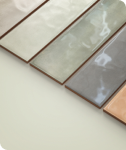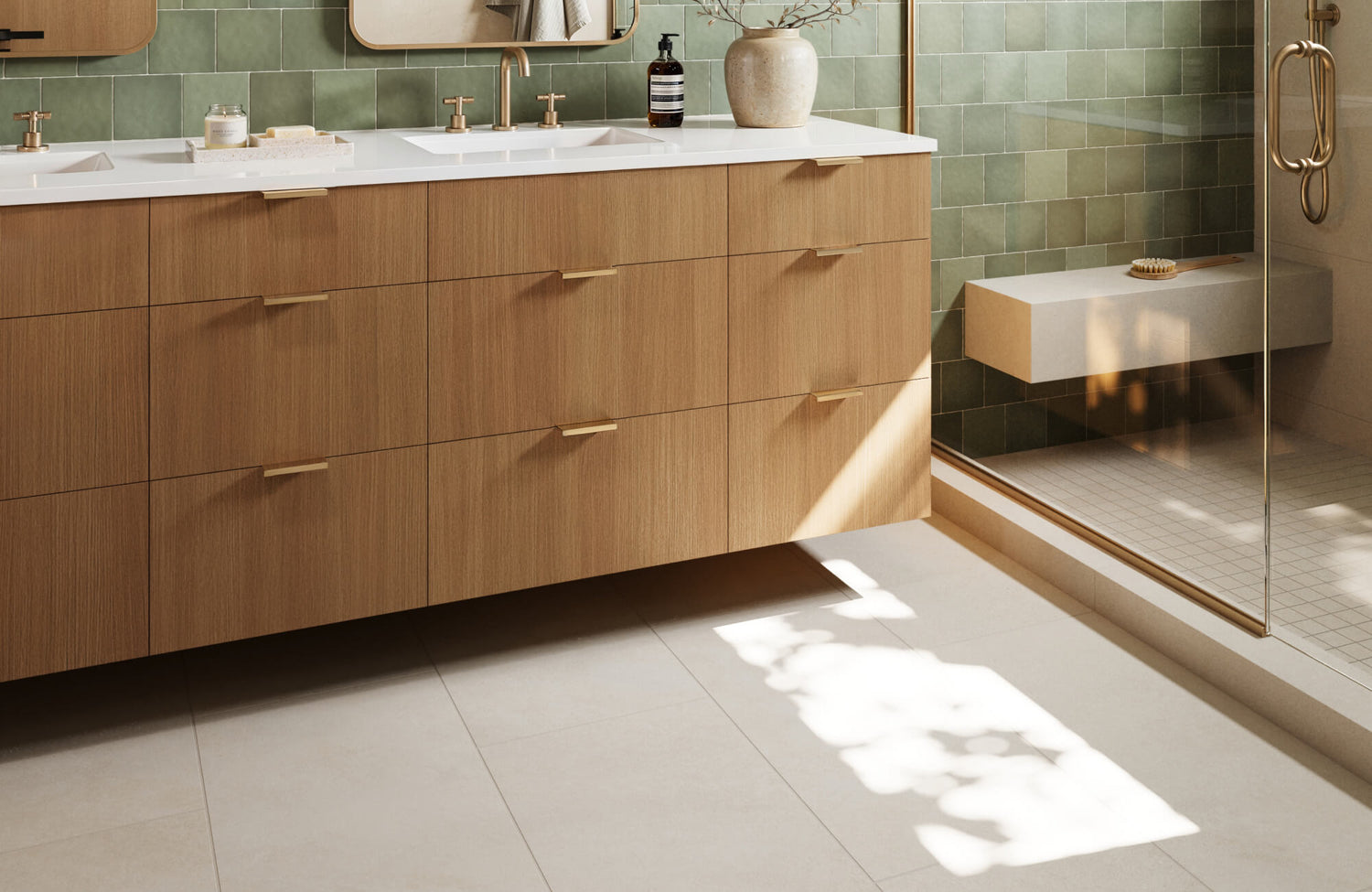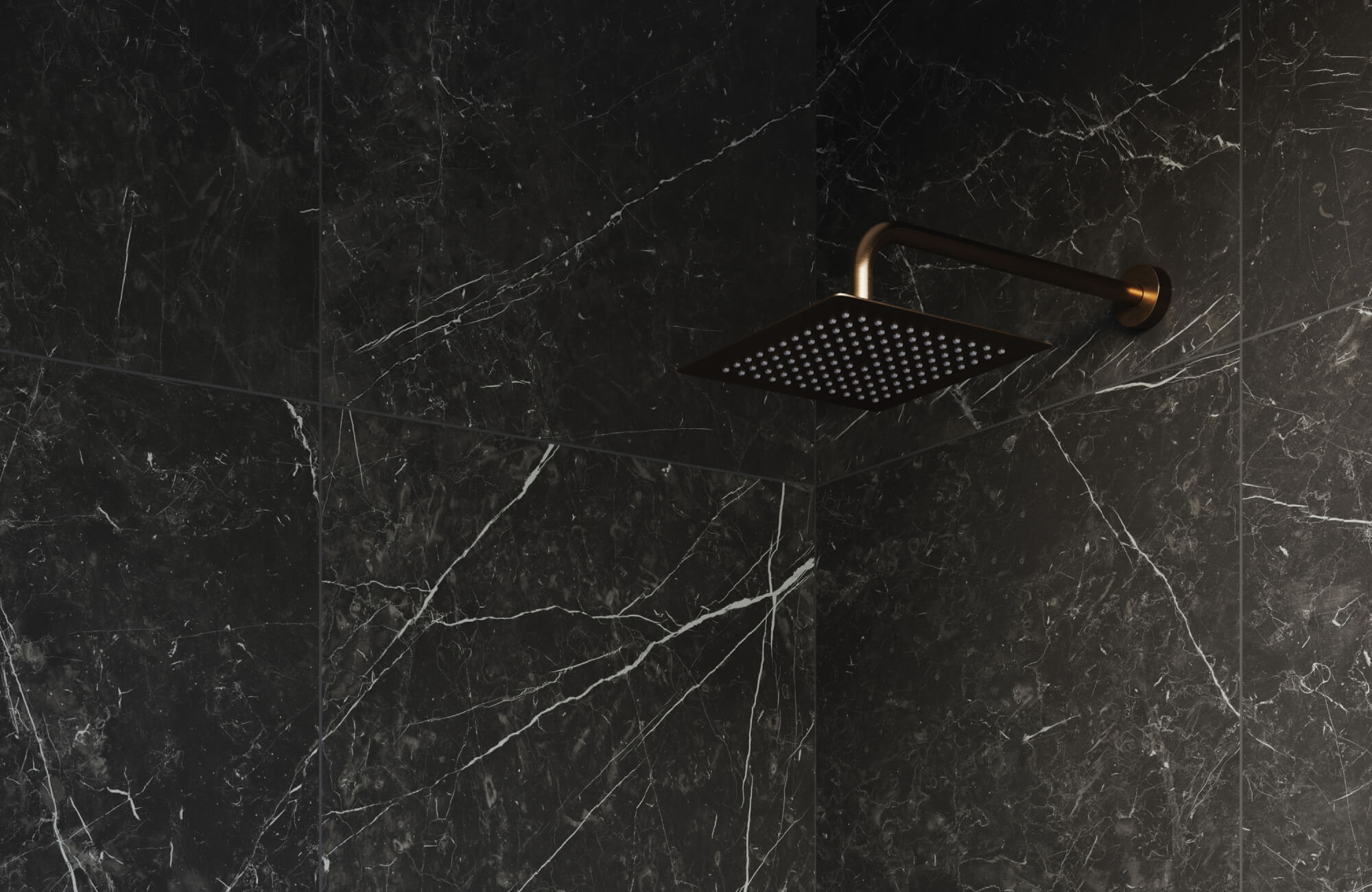Choosing the perfect bathroom floor tile can be a daunting task that balances aesthetics, safety, durability, and practicality. With numerous tile options available, factors like moisture resistance, slip resistance, and maintenance requirements play crucial roles. Selecting the right tile can elevate your bathroom’s design, creating a relaxing, functional, and long-lasting environment.
In this article, we’ll explore popular materials like ceramic and porcelain, as well as luxurious options such as natural stone. We’ll also discuss unique and alternative tile types for those seeking distinctive aesthetics. By the end, you’ll have the knowledge to make an informed choice, ensuring your bathroom floor is both beautiful and built to last.

Top Picks for Bathroom Floors
Among the most popular materials, porcelain, ceramic, and natural stone each bring unique benefits and considerations.
Porcelain
Porcelain tile is renowned for its exceptional durability and water resistance, making it a prime choice for bathrooms. Its dense, nonporous structure effectively repels moisture, preventing water damage and mold growth. This durability is particularly valuable in frequently used areas like showers and wet rooms.
Beyond its functional benefits, porcelain offers extensive customization options, from classic white subway styles to vibrant patterns and textures. An excellent example is the Adeline 24x24 Matte Porcelain Tile in Midnight, as shown in the photo above, which combines a deep, elegant shade with a matte finish, adding a touch of sophistication to contemporary bathroom settings. Porcelain’s versatility also ensures it can accommodate a broad spectrum of design preferences, making it suitable for both classic and contemporary aesthetics.
However, keep in mind that porcelain can feel cold underfoot, especially in colder climates. Additionally, while porcelain is generally affordable, certain higher-end designs, like specialty finishes or larger format tiles, may carry a higher price point. Nonetheless, this balance of affordability and sophistication makes porcelain a highly adaptable choice for bathroom flooring.
Ceramic
Ceramic tile is a long-standing favorite in bathroom design due to its affordability, versatility, and reliable moisture resistance. Its glazed surface effectively repels water, making it suitable for most bathroom applications. With a wide range of colors, patterns, and finishes available, ceramic tiles can suit both traditional and modern aesthetics. For Instance, the Marsden 3x10 Matte Ceramic Tile in Sand combines a warm, neutral tone with a matte finish, adding a sophisticated touch to any bathroom style.
Though ceramic is cost-effective, it is softer than porcelain and may chip if subjected to heavy impact, making it better suited to less busy areas or walls. With proper care and maintenance, however, ceramic tiles can provide enduring beauty and functionality.
Natural Stone
Natural stone offers a luxurious, timeless option for bathroom floors, including choices like granite, marble, and slate, each with unique textures and colors. While natural stones bring elegance, they often require sealing to maintain durability in moist environments and tend to be more expensive.
Granite
This hardy stone offers high resistance to scratches, chips, and stains, ideal for bathroom floors. Its extensive color options range from polished to rustic and textured finishes, accommodating varied aesthetics. Although granite is relatively low-maintenance, periodic sealing is essential to protect granite’s finish against stains and water damage.
Marble
Marble tiles bring an unmatched luxury with their smooth, polished surfaces and intricate veining patterns. Known for their timeless appeal, marble tiles create a sophisticated and elegant ambiance that few other materials can rival. However, marble is softer than granite, which makes it more prone to scratches and etching from daily use. To maintain its shine and protect against potential damage, regular sealing and cleaning are also recommended.
If you’re seeking the refined look of marble with lower maintenance and higher durability, marble look tiles are an excellent alternative. Made from materials like porcelain, these tiles replicate the elegant veining and polished finish of marble while offering a more resilient, easy-care solution, perfect for busy bathrooms.
Slate
Slate, with its naturally cleft surface, brings a rustic and earthy charm to bathroom floors. Known for its durability and weather resistance, it is well-suited for busy areas and can endure the demands of bathroom environments. Its unique texture and depth also provide traction, reducing slip risks, but occasional sealing is necessary to protect it from stains and water damage.
Natural stone tiles add character and longevity to bathrooms, especially for those aiming for a high-end finish. While these tiles are well-suited to many bathroom designs, there are also alternative materials that offer unique aesthetics and qualities for those looking to create a more distinctive space.

Exploring Unique Tile Alternatives
Beyond porcelain, ceramic, and natural stone, several alternative materials offer distinctive aesthetics for those who desire a unique bathroom style. Each alternative has specific qualities that cater to different design goals and functional needs.
Terracotta
Terracotta, made from fired clay, offers a warm, rustic ambiance with its earthy tones and natural textures. Available in red, orange, and brown hues, terracotta can transform a bathroom into a serene, spa-like space.
A key advantage of terracotta tiles is their natural beauty and ability to absorb moisture due to their porous nature. This characteristic can create a naturally humid environment, which may even benefit skin health. However, this same porosity requires regular sealing to prevent stains and water damage. While terracotta is generally durable, it is susceptible to scratches and chips with heavy use, making it best suited for less busier bathrooms. Regular cleaning and maintenance, including sealing every few years, are essential to preserving the tiles' appearance and longevity.
Mosaic
Mosaic tiles, composed of small, individual pieces, offer a versatile and artistic option for bathroom floors. Their intricate patterns and rich color options make them ideal for adding a luxurious touch and creating striking focal points. Mosaics are particularly recommended for shower floors due to their excellent slip resistance and adaptability to sloped surfaces.
Available in a variety of shapes like penny rounds, hexagons, and classic squares, mosaic tiles can suit any style preference, from a timeless, geometric look to a modern, abstract pattern. This versatility allows for endless customization options, helping you achieve a truly personalized design while also prioritizing safety and functionality in wet areas like the shower.
While visually appealing, mosaic tiles can be more time-consuming and labor-intensive to install than traditional tiles. The smaller size and intricate patterns require careful planning and execution. Additionally, cleaning and maintenance can be more challenging due to the grout lines between the individual pieces. To ensure proper care, it is essential to use a soft-bristled brush and a mild cleaning solution to avoid damaging the grout.
Luxury Vinyl Tile (LVT)
Luxury vinyl tile (LVT) has emerged as a popular and versatile flooring choice, offering a surprising combination of durability, water resistance, and aesthetic appeal. Unlike traditional vinyl flooring, LVT is composed of multiple layers, including a wear layer, a printed layer, and a vinyl core, providing resistance to scratches, stains, and moisture.
One of the most appealing aspects of LVT is its ability to mimic the appearance of natural materials such as wood, stone, and ceramic. With advancements in printing technology, LVT manufacturers can now produce tiles that are virtually indistinguishable from their real-world counterparts. This versatility allows homeowners to achieve a high-end look without the associated costs and maintenance requirements of natural materials.
In addition to its aesthetic appeal, LVT offers a warm and comfortable underfoot feel. This is especially beneficial in bathrooms, where cold floors can be a common discomfort. LVT's cushioned backing provides added comfort and reduces the risk of slips and falls. However, it is important to note that LVT may not be as durable as traditional tiles in frequently used areas or when subjected to heavy objects.
Pebble Tile
For a natural, spa-inspired aesthetic, pebble tiles bring the beauty of the outdoors indoors. Their irregular shapes and textures create a tactile experience and excellent traction, reducing the risk of slips and falls, ideal for wet areas. They are durable, water-resistant, and easy to clean, but pebble tiles require diligent cleaning and sealing due to the intricate patterns and numerous grout lines, which can accumulate dirt and grime over time. Additionally, their weight can place stress on subfloors, making it essential to ensure that the underlying structure can support them. Consulting a professional for installation is recommended to determine feasibility and maintain long-term durability.
Wood
Wood flooring in bathrooms may seem unconventional, but with proper treatment, it can be a stunning and durable choice. Wood's natural beauty and warmth create a serene and inviting atmosphere, and it’s comfortable underfoot, helping to reduce noise in the bathroom. However, wood is susceptible to water damage, so choosing a waterproof or water-resistant wood species and applying a high-quality sealant is essential. Regular maintenance, including cleaning and resealing, is also required to prevent swelling, warping, and rot. Though wood flooring can enhance a bathroom's aesthetic, it typically comes at a higher cost than other options, factoring in both installation and ongoing upkeep.
If you’re looking for a similar aesthetic with less maintenance, wood-look tiles are an excellent alternative. Made from materials like ceramic or porcelain, wood-look tiles mimic the grain and texture of natural wood, offering durability, water resistance, and ease of upkeep, making them a practical yet stylish choice for bathroom floors.

Factors to Consider When Choosing Your Bathroom Tile
Now that we've explored different tile materials, let’s examine essential factors to ensure your bathroom floor is both functional and visually appealing. Key considerations include slip resistance, tile size, and overall design, all of which play a crucial role in creating a safe, stylish, and practical bathroom space.
Moisture Resistance
Bathrooms are moisture-prone environments, so choosing tiles with high water resistance is crucial. Porcelain, ceramic, and LVT excel in moisture resistance, while natural stone requires regular sealing to prevent water damage. If opting for wood or terracotta, ensure they are properly sealed and maintained to withstand damp conditions.
Slip Resistance
Slip resistance is a crucial factor for bathroom safety, especially for families with young children, seniors, or individuals with mobility impairments. Opt for tiles with a textured or matte finish, like the Tatum 12x24 Matte Porcelain Tile in Cross-Cut Sand, as these surfaces provide better traction than glossy finishes.
When selecting tiles for wet areas like showers and tubs, look for those with a high coefficient of friction (COF). The COF measures a tile's resistance to slipping, and a higher COF indicates greater safety. Additionally, consider using slip-resistant mats or rugs in areas where water is likely to accumulate.
Maintenance and Durability
Durability and maintenance is another important factor to consider. Porcelain and ceramic tiles are highly durable and generally require minimal upkeep, making them popular choices for long-lasting bathroom floors. Natural stone tiles, while elegant, are more prone to scratching or etching and, as previously highlighted, require periodic sealing to maintain their appearance. Luxury Vinyl Tile (LVT), on one hand, provides a balance of durability and affordability and is also relatively easy to clean and maintain.
Size Matters
The size of the tiles you choose can significantly impact the overall appearance and feel of your bathroom. Larger format tiles can create a clean, minimalist look and make a small bathroom appear more spacious. In contrast, smaller tiles can add visual interest and create intricate patterns.
Consider also the size of your bathroom and your desired aesthetic when selecting tile sizes. For an industrial, open-space aesthetic, opt for large format tiles with a concrete or stone finish, enhancing the raw, expansive feel. If you prefer a more traditional or ornate style, smaller tiles can be a great choice.
Ease of Installation
The ease of installation varies among tile types, influencing both cost and feasibility for DIY projects. Ceramic and porcelain tiles are relatively easy to install, whereas mosaic and natural stone tiles may require professional handling. LVT is often considered one of the easiest flooring materials to install, making it a popular choice for DIY projects.
Cost
The cost of bathroom tiles depends on the material, size, and brand. Porcelain and ceramic tiles are generally more affordable, ranging from $1 to $15 per square foot, offering durability and variety. Natural stone tiles, such as marble or granite, are on the higher end, typically costing between $7 and $20 per square foot due to their unique textures and luxurious appeal. Luxury Vinyl Tile (LVT), on one hand, falls in the mid-range, averaging around $2 to $12 per square foot, providing a balance of style, resilience, and lower maintenance. Carefully consider your budget while balancing aesthetics, durability, and upkeep needs.

Designing Your Dream Bathroom Floor
Creating a bathroom floor that reflects your style involves more than selecting tile materials. Consider the overall color scheme, lighting, and layout to achieve a cohesive look. Here are a few tips for designing a bathroom floor that complements your vision:
Color Scheme
White or light-colored tiles offer a classic look, enhancing brightness and making the space appear larger. Bold patterns or dark tones, on one hand, can create a modern, dramatic effect but work best in larger spaces with ample lighting. To help envision your chosen color scheme, consider using our AR tool, which allows you to preview a variety of tile styles directly in your bathroom space through your smartphone or tablet. This augmented reality feature offers a realistic view of how different colors and patterns will look, enabling you to make confident design choices from the comfort of your home.
Pattern and Texture
Experiment with patterns like herringbone, basketweave, or chevron to add texture and depth. Mosaic and pebble tiles offer unique patterns, while wood or terracotta bring warmth and natural charm. To help you visualize these options for your bathroom floors, we offer high-quality 4" x 4" samples that provide an accurate representation of color and finish across all tile sizes within each collection, ensuring you receive a true sense of the texture and tone before making a final choice.
Customization
Personalizing your tile layout and design allows you to create a bathroom that reflects your unique style. Combining classic subway tiles with a patterned accent or mixing various tile sizes can make your floor a true focal point. For guidance in achieving a cohesive and personalized look, consider consulting our interior design experts at Edward Martin. They can offer professional insights and recommendations to bring your vision to life.
Selecting the Ideal Bathroom Floor Tile
Choosing the right bathroom floor tile is essential for creating a space that’s both functional and visually appealing. From moisture-resistant porcelain and ceramic to luxurious natural stone and unique alternatives like mosaic and pebble, there’s a perfect tile for every design preference and practical need.
Remember to prioritize factors like slip resistance, ease of maintenance, and tile size in your selection process. Balancing these elements with your desired aesthetic will help you create a bathroom that is safe, stylish, and tailored to your needs. With thoughtful planning and design, your bathroom floor can become a beautiful, long-lasting sanctuary of relaxation and style.







